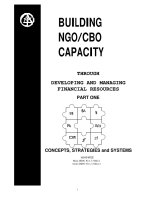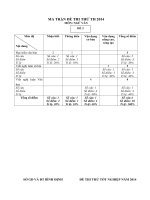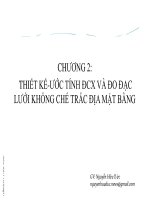Managing Financial Resources and Decisions Assignment 2 BTEC Nguyen Huu Phong 2017
Bạn đang xem bản rút gọn của tài liệu. Xem và tải ngay bản đầy đủ của tài liệu tại đây (742.92 KB, 19 trang )
ASSIGNMENT FRONT SHEET <No.2>
Qualification
BTEC Level 5 HND Diploma in Business
Unit number and title
H/601/0548: Managing Finance Resources and Decisions
Assignment due
Assignment submitted
Learner’s name
Dương Thừa Phát
Assessor name
Trương Ngọc Thịnh
Learner declaration:
I certify that the work submitted for this assignment is my own and research sources are fully acknowledged.
Learner signature
Date
Grading grid
P4.1
P4.2
P4.3
Assignment title
P4.4
M1
M2
M3
D1
D2
Evaluate Financial Performance
1
D3
In this assignment, you will have opportunities to provide evidence against the following criteria.
Indicate the page numbers where the evidence can be found.
Assessment criteria
Expected evidence
Task
no.
LO4. Be able to evaluate the financial performance of a business
Financial statements: Basic form,
4.1 Discuss the main structure and purpose of main
financial statements ie balance
financial statements
sheet, income statement, cash
flow statement.
How different types of finance
4.2 Explain the impact of
and their costs appear in the
finance on financial
financial statements of a
statement
business; the interaction of assets
and liabilities on the balance
Distinctions between different
4.3 Compare appropriate
formats of financial statement
formats of financial
fordifferent types of businesses ie
statements for different
limited company, sole trader.
types of business
4.1
4.2
4.3
2
Assessor’s Feedback
4.4 Interpret financial
statements using
appropriate ratios and
comparisons, both internal
and external.
Assessment criteria
Merit descriptor No. (M1)
Merit descriptor No. (M2)
Merit descriptor No. (M3)
Distinction descriptor No.
(D1)
Distinction descriptor No.
(D2)
Distinction descriptor No.
(D3)
Key accounting ratios for
profitability, efficiency and
investment; comparison both
external ie other companies,
industry standards and internal ie
previous periods.
4.4
Expected Evidence
Feedback
(note on Merit/Distinction if applicable)
Identify and apply strategies to
find appropriate solutions.
Select/design and apply
appropriate methods/techniques
Present and communicate
appropriate findings
Use critical reflection to evaluate
own work and justify valid
conclusions.
Take responsibility for managing
and organizing activities
Demonstrate convergent/ lateral/
Creative thinking
Summative feedback
3
Assessor’s Signature
IV Grading Check:
Date
Comments if any:
Agree
Disagree
Modify grade to
IV Signature
Date
4
<ATTACHED EVIDENCE>
5
Contents
Introduction
7
LO4. Be able to evaluate the financial performance of a business
4.1 Discuss the main financial statements
7
4.2 Explain the impact of finance on financial statement
10
4.3 Compare appropriate formats of financial statements for different
types of business
11
4.4 Interpret financial statements using appropriate ratios and
comparisons, both internal and external
12
Conclusion
18
References
6
Introduction
Any business in the market when it comes to operations and development when it comes to outside capital
needs to disclose information about the situation, growth, and development of that business. A specific
financial report. In this report, I will detail the corporate financial statements and how important it is to a
business.
LO4. Be able to evaluate the financial performance of a business
4.1 Discuss the main financial statements
In this section, I will introduce related articles in financial statements such as Income statement, Balance
sheet, and Cashflow statement. I will detail each of the items below.
Financial statements record all activities of a business, its development, and growth. The analysis of
financial statements helps us to understand whether a business is performing well, the analysis of financial
statements enables investors to make the decision whether to invest or to withdraw from the business
before the business down or not.
As mentioned above, the basic financial statement will have three main parts: Income statement, Balance
sheet, Cashflow statement.
Income statement
The income statement is a measure of the performance of a business over a specified period of time, which
is up to the fiscal year. Through the income statement, we can see the profit or loss of that business.
Here is an example of what an income statement looks like and includes:
7
(education.howthemarketworks.com, 2016)
This report includes key elements such as revenue, financial expenses, selling expenses, income tax and
other revenues. Income statements are used to evaluate whether a business is doing well and making a
profit, and of course it is published quarterly or fiscal year.
8
From the income statement, evaluators can analyze the change and growth of that business in the field of
business. On the other hand, they also calculate dividends and profit margins that investors earn when the
company is profitable.
Balance sheet
The balance sheet includes the assets, liabilities and equity of an enterprise. The balance sheet will
indicate the financial status and economic resources of an enterprise, based on which it can assess the
amount of the business loan.
The balance sheet follows the formula:
Assets = Liabilities + Equity
(myaccountingcourse.com, 2016)
Assets are what a business owns and are usually measured in cash. There are two types of assets that are
long-term assets and short-term assets.
Long-term assets include long-term investments such as bonds, real estate, buildings, facilities, machinery,
etc. In addition, long-term assets may include knowing- Formula secret or patent, the brand of a business.
Short-term assets include assets that will be sold, transferred to cash and can be used to liquidate shortterm liabilities. Specific short-term assets include cash, receivables. A liability is considered a debt of a
9
business. Debts include short-term and long-term loans, more specifically, wages, taxes, loans from
outside. Equity is the number of assets that the owner of the business, the shareholder contributing to the
company, and the equity can be called "net assets." Income is reinvested in the business or used to pay off
debt, then it is distributed to shareholders under their holding, which is called dividends.
Cashflow statement
Cashflow statements are reports that a
business must report to authorities and the
public. The cashflow statement evaluates
an enterprise's cash flow by three main
activities, investment and financing.
Cashflow statements help to point out
information that can help assess the quality
of your business's income, liquidity, and
liquidity.
(myaccountingcourse.com, 2016)
4.2 Explain the impact of finance on financial statement
According to Investopedia stated that: "Interest expense is the cost incurred by an entity for borrowed
funds. Interest expense is a non-operating expense shown on the income statement. It represents interest
payable on any borrowings – bonds, loans, convertible debt or lines of credit."
Cost of goods sold (COGS) are the direct costs attributable to the production of the goods sold by a
company. This amount includes the cost of the materials used in creating the good along with the direct
10
labor costs used to produce the good. It excludes indirect expenses such as distribution costs and sales
force costs.
Beside that, according to Investopedia state that: "A tax expense is a liability owing to federal,
state/provincial and municipal governments. Tax expenses are calculated by multiplying the appropriate
tax rate of an individual or business by their income before taxes, after factoring in such variables as nondeductible items, tax assets and tax liabilities."
The capital of an enterprise usually consists of two sources, the owner's capital and the source of capital,
or debt. It is indispensable for a business to combine both equity and equity. However, balancing these two
types is also a necessity and flexibility in each period. If an enterprise owes too much debt, it will lead to
higher debt, higher interest expenses and an impact on profitability in the statement of income. The highinterest expense will greatly affect the net revenue of the business to pay a large proportion of interest
expenses. On the other hand, the high-interest expense will cause the amount of cash to fall and the
revenue from the business result will also decrease.
Capital expenditures have a large impact on the balance sheet and are influenced by the source of business
use. The basic thing is that when the cost of sales is lower and the cost of capital is not balanced, the
business will suffer a certain loss. This is a negative situation when it affects both the ability to pay the
charges and interest expenses, debts of that business.
Taxation is a mandatory requirement that any business must be obliged to pay to governments in the
countries in which it operates. The tax is calculated based on the net income of a business and does not
affect the debt. This is the point where so many companies around the world are spilling billions of dollars
in taxes like Google, Apple, Facebook, etc. These businesses usually borrow money from outside to
invest, even though their finances are big. The main purpose is to avoid too high taxes when their revenue
is too large.
4.3 Compare appropriate formats of financial statements for
different types of business
Definition
Sole Traders
Partnerships
A sole trader is the simplest form
of business structure and is
relatively easy and inexpensive to
set up. As a sole trader you will be
legally responsible for all aspects
of the business. You’ll generally
make all the decisions about
starting and running your business
and you can employ people.
A type of business organization in
which two or more individuals pool
money, skills, and other resources,
and share profit and loss in
accordance with terms of the
partnership agreement.
11
Advantages and
disadvantages
Formats of financial
statements
As
a
small
business,
organizational structure is simple
and easy to manage. The initial
investment cost is not high and
the number of employees is low,
so the salary cost is low. Most
importantly, control and decision
making in the enterprise category
is much easier, often led by the
founder.
Business activities are limited by
the owner's capital. Problem
solving ability is not high due to
concentration in one person. All
responsibilities are concentrated
on the owner and the personal
income tax is higher than the
larger corporate tax.
Since only a business owner
establishes and owns the business
owner's capital, business income
is considered income of the
business owner. This tax will not
be counted as corporate income
tax but will be charged as personal
income tax. The weak point is that
personal income tax is higher than
corporate income tax.
Flexible capital is a big strength when
many people contribute capital. The
ability to solve problems is higher
due to the mutual support between the
capital contributors. The amount of
work spread and reduced the
pressure, not focusing on too many
people.
Disagreement is a huge limitation of
this type of business. In addition,
profit is a sensitive issue as there are
many contributors and are often not
clearly divided.
Financial statements of this type of
business will be evaluated as
financial statement for the enterprise
as this type of enterprise has higher
number of members.
4.4 Interpret financial statements using appropriate ratios and
comparisons, both internal and external
In this section, I will analyze the specific financial statements of a business so that we can see the growth,
growth and business of that business through multiple quarters.
The group I am analyzing in this section is Apple. Tech giant and being the most valuable corporation in
the world at just $ 810 billion in May 2017. Apple was founded by Steve Jobs and Steve Wozniak in 1976
and is currently led by CEO Tim Cook based in Cupertino, California.
Reported business operating results over the quarterly.
12
Income Statement
13
Balance sheet
14
Cashflow Statement
Looking at Apple's financial statements for the last three-quarters is the first quarter of 2017 and the fourth
quarter of 2016, we can see that Apple's revenue tends to rise extremely strong in the first quarter of 2017
and quarterly. The return to the average is slightly higher than the fourth quarter of 2016. Originally, this
may have been due to the fact that it sold its latest iPhone, the iPhone 7, and the huge consumer demand
that led to strong sales.
Q4 / 2016: Revenue of $ 46 billion and profit of $ 17 billion
Q1 / 2017: Revenues reach $ 78 billion and profits reach $ 30 billion. This is the quarterly sale of the
latest iPhone 7 / 7plus and the purchasing power is too great
Q2 / 2017: Revenue is only $ 52 billion and profit is $ 20 billion.
In general, Apple's business is growing quarter by quarter and has spiked to new quarter sales. Apple's
current business situation is very good.
15
Earnings per share
According to Investopedia stated that: “Earnings per share (EPS) is the portion of a company's profit
allocated to each outstanding share of common stock. Earnings per share serves as an indicator of a
company's profitability.”
Calculated as:
16
In this formula, dividend per share (DPS) is the total dividends paid out over a whole year (including
dividends but not including special dividends) divided by the number of outstanding ordinary shares
issued. Average Outstanding Shares can be the average number of shares in circulation or the number of
shares outstanding at the end of the year.
Q4/2016: (9.014x0,00228)/5.214 = 0,0039
Q1/2017: (17.891x0,00228)/5.214 = 0,0078
Q2/2017: (11.029x0,00228)/5.214 = 0,0048
We can see in the quarter, the earnings per share Apple is uneven and the highest is still Q1 / 2017.
Price-Earnings Ratio
According to Investopedia stated that: “The price-earnings ratio (P/E ratio) is the ratio for valuing a
company that measures its current share price relative to its per-share earnings. The price-earnings ratio is
also sometimes known as the price multiple or the earnings multiple.”
Calculated as:
The price-earnings ratio (P/E ratio) = Market Value per Share / Earnings per Share
Q4/2016: 113/0,0039 = 28,9
Q1/2017: 155/0,0078 = 19,87
Q2/2017: 143/0,0048 = 29,7
Apple's Price-Earnings Ratio continues to rise sharply in Q1 / 2017 and decline in Q2 / 2017 growth.
Return on Assets Ratio – ROA
According to Investopedia stated that: "Return on assets (ROA) is an indicator of how profitable a
company is relative to its total assets. ROA gives an idea as to how efficient management is at using its
assets to generate earnings. Calculated by dividing a company's annual earnings by its total assets, ROA is
displayed as a percentage. Sometimes this is referred to as "return on investment"."
17
Calculated as:
Return on Equity ratio (ROE)
According to Investopedia stated that: "Return on equity (ROE) is the amount of net income returned as a
percentage of shareholders equity. Return on equity measures a corporation's profitability by revealing
how much profit a company generates with the money shareholders have invested."
Calculated as:
Looking at the table above, we can see that Apple's ROA and ROE are always sharply increased in Q1 /
2017 (ROA of 5.4% and ROE of 13.5%) and then fall in Q2 / 2017 Growth and till higher than Q4 / 2016.
This is a good sign that Apple's business is very good, and revenue is a big part of it.
Conclusion
Through this report we can see how important financial statements are for a business and on which we can
assess the business situation, the level of growth and development of the business. Karma to make the
right investment decision.
18
References
•
Aaplinvestors (2017) Sales & Income, Aaplinvestors.net, [online] Available at:
(Accessed 5 June 2017).
•
Brookshire, M. (2017) Income Statement Definition and Example, HowTheMarketWorks Education Center, [online]
Available at: (Accessed 5 June 2017).
•
Google Finance (2017) Financial Statements for Apple Inc. - Google Finance, Google.com, [online] Available at:
(Accessed 5 June 2017).
•
Myaccountingcourse (2017) Balance Sheet | Example | Template | Format, My Accounting Course, [online] Available
at: (Accessed 5 June 2017).
•
Myaccountingcourse (2017) Statement of Cash Flows Direct Method | Format | Example, My Accounting Course,
[online] Available at: />(Accessed 5 June 2017).
•
Smallbusiness (2017) Sole Trader | Small Business, Smallbusiness.wa.gov.au, [online] Available at:
(Accessed 5 June 2017).
•
Staff, I. (2017) Cost Of Goods Sold - COGS, Investopedia, [online] Available at:
(Accessed 5 June 2017).
•
Staff, I. (2017) Earnings Per Share - EPS, Investopedia, [online] Available at:
(Accessed 5 June 2017).
•
Staff, I. (2017) Interest Expense, Investopedia, [online] Available at:
(Accessed 5 June 2017).
•
Staff, I. (2017) Price-Earnings Ratio - P/E Ratio, Investopedia, [online] Available at:
(Accessed 5 June 2017).
•
Staff, I. (2017) Return On Assets - ROA, Investopedia, [online] Available at:
(Accessed 5 June 2017).
•
Staff, I. (2017) Return On Equity - ROE, Investopedia, [online] Available at:
(Accessed 5 June 2017).
•
Staff, I. (2017) Tax Expense, Investopedia, [online] Available at: />(Accessed 5 June 2017).
•
Ycharts (2017) Apple Shares Outstanding (AAPL), Ycharts.com, [online] Available at:
(Accessed 5 June 2017).
19









